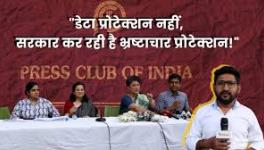ISIS Gains Power and Innocents Die as Syria Retreats From Peace

Syrian refugees in Lebanon staying in cramped quarters, 3 September 2012. Photo Credit: Voice of America News: Margaret Besheer reports from the northern Lebanese city of Tripoli; "Syrian Refugees Seek Out Smugglers". [Public domain],via Wikimedia Commons
A few months ago, it appeared as if the local ceasefires and the new geo-political realignments had moved Syria towards the end of its fratricidal six-year civil war. The Syrian government and the Turkey-based leadership of a section of the armed opposition met in Astana (Kazakhstan) and discussed the technical matters of de-escalation. Iran and Qatar had produced very important breakthroughs around towns under siege. There was no easy pathway to a peace deal, but there appeared to be signs that indicated the possibility of a genuine dialogue.
Meanwhile, at Syria’s north and Iraq’s northwest, it appeared as if ISIS would be soon squashed by the massive firepower of the various global players and by the resolve of the various militaries in the region. Gains in Mosul and in the Syrian Desert towns indicated that ISIS would have few options left to exert itself. It would not disappear – for it still commands the allegiance of a large number of fighters and sympathizers – but it would be considerably weakened.
Certainly, the ceasefire dialogue in Astana and the UN-led process in Geneva indicated that the Syrian government had the better bargaining position. Its forces – aided by Iran, Russia and other regional fighting units – had defeated the rebel forces in Aleppo and seemed poised to weaken them further in Idlib. The Syrian government’s forces had removed ISIS from Palmyra and seemed prepared to break the ISIS siege on the western city of Deir ez-Zor. A study of the battlefield in Syria indicates that between 1 April 2016 and 31 March 2017, 43 per cent of the Syrian army’s battles were against ISIS (this is contrary to the view that the Damascus government has not engaged ISIS).
Regime Change
Much changed in the politics of the region when US President Donald Trump authorized the missile strikes on the Syrian government’s air base on 7 April. This is not to say that the airstrikes had a major military effect on the Syrian army, but it did muddy the balance of forces in this bloody war and it will serve to extend the war and break the gestures for peace.
Just before these missile strikes, the Syrian opposition in Istanbul (Turkey) had asked for greater US involvement in the negotiations. The opposition had come to the view that US military action against the government of Bashar al-Assad was no longer possible. Trump’s missile strikes invalidated their assumption. It is now thought amongst the political leaders of the armed opposition that the US might launch a full-scale attack on the Syrian army and deliver Damascus to them.
It is a curious matter that the journalist Anand Gopal told Democracy Now that ‘I think it’s important to understand that there’s no regime change policy from the United States towards Syria. And there never has been a regime change policy.’ This view blinds itself from the decade-long attempt by the US government to overthrow the Syrian government in order to weaken Iran and Hezbollah (as I show in my book, The Death of the Nation and the Future of the Arab Revolution). It also fails to see that ‘regime change’ is not always accomplished by the kind of massive bombardment seen in Iraq (2003) and Libya (2011). In Syria, the armed opposition knew from 2011 that it would not defeat the Assad government without the accompaniment of massive US airstrikes. This is why it has sought to encourage US intervention. Obama’s slogan - ‘Assad must go’ – and the adventures of US Ambassador Robert Ford to opposition protests suggested to the armed opposition that the US cruise missiles were on the way.
The shadowy promises from the United States prolonged this war, with the rebels unwilling to come to the table because they assumed that the maximal position (regime change) would be reality. At the same time, the US along with its Gulf Arab allies and Turkey financed and armed the opposition through Turkey and Jordan. This program was known as Timber Sycamore, which was the pipeline for millions of dollars of arms that entered not only the various rebel forces but also the black market. The hope that the US will eventually overthrow Assad remains central to the strategy of even the al-Qaeda proxy. Trump’s 7 April strike merely rekindled that hope and therefore broke the momentum of the peace talks.
The Pendulum of ISIS
Trump’s 7 April strike hit an airfield that – while bombing Idlib certainly – was also bombing ISIS positions outside Palmyra and toward Deir ez-Zor. Three days before Trump’s assault, Syrian army troops had moved closer to the significant Talilah crossroad, held by ISIS. They took the heights of al-Taj and al-Mazbad from ISIS. It appeared that the Syrian army was getting itself ready for an assault on the Talilah crossroad, whose capture would have allowed them to move on Deir ez-Zor, where 90,000 civilians are living in a wretched siege, and to the T3 airbase near Homs. The oil fields of al-Shaer and the gas fields of Arak would have been secured if the Syrian army had been able to take the crossroad.
Air cover came from the base that Trump’s cruise missiles hit, which delivered ISIS a momentary advantage on the ground. ISIS chatter now suggests that defeat in Mosul would be compensated by a victory in Deir ez-Zor. In practical terms, the Trump strike might very well have made this possible.
Meanwhile, the deeply fraught politics along the Turkish border has also allowed ISIS to breathe. Turkey’s intervention to prevent the advance of both the Syrian army and the US-backed largely Kurdish Syrian Democratic Forces has allowed ISIS to reorganize its forces to delay the fall of Raqqa and to go south to seize Deir ez-Zor. An ISIS suicide bomber killed dozens of refugees from this war zone on 2 May in Hasakeh province. These refugees sought to go into the zone controlled by the Syrian Democratic Forces. Such attacks are intended to sow fear amongst the population and in the ranks of those who are fighting ISIS.
Security Zones
The armed Syrian opposition has decided to no longer attend the Astana ceasefire talks, whose fourth round opened today. They now sniff the possibility of regime change in Damascus. Trump’s action indicates that peace is not necessary if victory remains a prospect.
Russia’s President Vladimir Putin spoke to Trump on 2 May. Putin asked Trump to endorse the Russian proposal for the creation of ‘security zones’ across Syria. Where a power is relatively dominant, it will guarantee the peace in that zone, and the various powers would ensure that attacks across zones would be curtailed. The four ‘security zones’ would be managed by the Russians, the Iranians, the Turks and the Americans. This framework resembles the Allied-occupation zones in Germany after World War 2. In their read-out of the phone call, the White House called these ‘safe, or de-escalation, zones’ – translating the Russian proposal into the language of ‘no-fly zones’ and ‘safe zones’ familiar to the American policy makers. In fact, Putin said openly that these ‘security zones’ would be ‘no-fly zones.’
At Astana, the main agenda item will be these ‘security zones,’ with a detailed document now doing the rounds of the participants. It is hoped that a final document – with the technical details for the boundaries, checkpoints, and monitoring procedures – will be ready by 22 May.
The armed Syrian opposition leadership rejected the proposal for safe zones. Ahmed Ramadan, leader of their delegation, told the Associated Press that the armed opposition was not happy with the idea of local truces. They wanted to secure a nation-wide policy. Ramadan’s delegation is in Astana, although they have not come to the table. The UN’s envoy Steffan de Mistura has urged Ramadan and his team to come back to the talks and not to ‘destroy the possibility of good news related to this issue.’
It is important to indicate that the Trump attack has also strengthened the sectarian world-view of the Saudi royal family – one of the main patrons of the armed Syrian opposition. On 2 May, the Saudi crown prince and defense minister Mohammed bin Salman told Saudi news media that his kingdom would never be able to have a dialogue with Iran. ‘How can I come to an understanding with someone, or a regime, whose principles are extremist?’ Iran, he argued, represented the Shia quest to ‘control the Islamic world.’ What Prince Salman indicated here was less the reality of Iran’s situation and more the paranoia of the Saudi government. Iran has been willing to meet with the Saudis to find a way to de-escalate the conflict in Syria and elsewhere. It has already been working with Qatar to do so, and is an active player at the Astana meetings. Recalcitrance may be found less in Iran and more in Saudi Arabia, which knows that Washington, DC will back its obstinacy to the hilt. Prince Salman’s comments have been well received by the armed opposition in Syria. They see this as confirmation that neither Trump nor Prince Salman is eager for peace in Syria. Both would like to see that war go on.
This article was made possible by the readers and supporters of AlterNet.
Disclaimer: The views expressed here are the author's personal views, and do not necessarily represent the views of Newsclick.
Vijay Prashad is professor of international studies at Trinity College in Hartford, Connecticut. He is the author of 18 books, including Arab Spring, Libyan Winter (AK Press, 2012), The Poorer Nations: A Possible History of the Global South (Verso, 2013) and The Death of a Nation and the Future of the Arab Revolution (University of California Press, 2016). His columns appear at AlterNet every Wednesday.
Get the latest reports & analysis with people's perspective on Protests, movements & deep analytical videos, discussions of the current affairs in your Telegram app. Subscribe to NewsClick's Telegram channel & get Real-Time updates on stories, as they get published on our website.
























